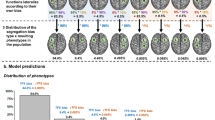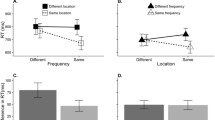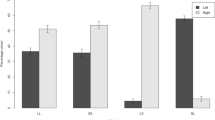Abstract
In a previous study (Hugdahl & Brobeck, 1986) it was shown that Pavlovian conditioning to an auditory verbal conditioned stimulus (CS) initially presented only to the left cerebral hemisphere was stronger than when the same CS was presented to the right hemisphere. This was followed up in the present study by controlling for the possibility that the effect was caused by laterally biased attention. The study was performed using the “dichotic extinction paradigm,” which consists of three different phases. During the habituation phase, the CS+ and CS- were presented binaurally and separated in time. During the acquisition phase, the CS+ was followed by a white-noise unconditioned stimulus (UCS). During the dichotic extinction phase, the CS+ and CS- were presented dichotically, i.e., simultaneous presentations on each trial. Half of the subjects had the CS+ in the right ear, and half had the CS+ in the left ear. Each group was further divided into two subgroups, with one subgroup instructed to attend only to the right ear input, and the other subgroup to attend only to the left ear input. During acquisition, larger electrodermal responses were obtained to the CS+ than to the CS-. During dichotic extinction, the CS+ right ear group showed superior resistance to extinction compared to the CS+ left ear group, with no effect of the manipulation of attention. The effect was, however, attenuated when levels of acquisition was used as covariates in an analysis of covariance. There were overall larger responses from the left hand recording.
Similar content being viewed by others

References
Bryden, M.P. (1978). Strategy effects in the assessment of hemispheric asymmetry. In G. Underwood (Ed.),Strategies of information processing (pp. 128–151). London: Academic Press.
Bryden, M.P., Munhall, K., & Allard, F. (1983). Attentional biases and the right-ear effect in dichotic listening.Brain and Language, 18, 236–248.
Connolly, J.F. (1985). Stability of pathway hemispheric differences in the auditory event-related potential (ERP) to monaural stimulation.Psychophysiology, 22, 87–96.
Corballis, M.C. (1986). Fresh fields and postures new: A discussion paper.Brain and cognition, 5, 240–252.
Corteen, R.S. & Wood, B. (1972). Autonomic response to shock-associated words in an unattended channel.Journal of Experimental Psychology, 94, 303–313.
Davey, G.L.C. (1987). An integration of human and animal models of Pavlovian conditioning: Associations, cognitions, and attributions. In G.L.C. Davey (Ed.),Cognitive processes and Pavlovian conditioning in humans (pp. 83–114). Chichester, UK: Wiley.
Dawson, M.E., & Schell, A.M. (1982). Electrodermal responses to attended and nonattended significant stimuli during dichotic listening.Journal of Experimental Psychology: Human Perception and Performance, 8, 82–86.
Dawson, M.E. & Schell, A.M. (1987). Human autonomic and skeletal classical conditioning: The role of conscious cognitive factors. In G.L.C. Davey (Ed.).Cognitive processes and Pavlovian conditioning in humans (pp. 27–55). Chichester, UK: Wiley.
Dawson, M.E., Schell, A.M., Beers, J.R., & Kelly, A. (1982). Allocation of processing capacity during human autonomic classical conditioning.Journal of Experimental Psychology: General, 111, 273–295.
Dimond, S.J. & Farrington, J. (1977). Emotional response to films shown to the right or left hemisphere of the brain measured by heart rate.Acta Psychologica, 41, 255–260.
Fowles, D.C., Christie, M.J., Edelberg, R., Grings, W.W., Lykken, D.T., & Venables, P.H. (1981). Publication recommendations for electrodermal measurements.Psychophysiology, 18, 232–239.
Gainotti, G. (1972). Emotional behavior and hemispheric side of the lesion.Cortex, 8, 41–55.
Grings, W.W. (1960). Preparatory set variables related to classical conditioning of autonomic responses.Psychological Review, 67, 243–252.
Hugdahl, K. (1984). Hemispheric asymmetry and bilateral electrodermal recordings: A review of the evidence.Psychophysiology, 24, 371–394.
Hugdahl, K. (1987). Pavlovian conditioning and hemispheric asymmetry: A perspective. In G.L.C. Davey (Ed.),Cognitive processes and Pavlovian conditioning in humans (pp. 147–182). Chichester, UK: Wiley.
Hugdahl, K., Qundos, O., & Vaittinen, J. (1982). Effects of hemispheric asymmetry on electrodermal conditioning in a dichotic listening paradigm.Pavlovian Journal of Biological Science, 17, 120–129.
Hugdahl, K., Nordstrand, L., & Engstrand, O. (1986). Agraphic-interactive CAD system for dichotic stimulus alignment (CADDIC).Psykologisk Rapportserie, Universitetet i Bergen, 7, nr.3.
Hugdahl, K., & Brobeck, C.G. (1986). Hemispheric asymmetry and human electrodermal conditioning: The dichotic extinction paradigm.Psychophysiology, 23, 491–499.
Hugdahl, K., & Andersson, L. (1986). The “forced-attention paradigm” in dichotic listening to CV-syllables: A comparison between adults and children.Cortex, 22, 417–432.
Hygge, S., & Hugdahl, K. (1985). Skin conductance recordings and the NaCl concentration of the electrolyte.Psychophysiology, 22, 365–367.
Ketterer, M.W. & Smith, B.D. (1977). Bilateral electrodermal activity, lateralized cerebral processing and sex.Psychophysiology, 14, 513–516.
Kimble, G.A. (1961).Hilgard and Marqui’s conditioning and learning. New York: Appleton-Century-Crofts.
Kimura, D. (1961). Cerebral dominance and the perception of verbal stimuli.Canadian Journal of Psychology, 15, 166–171.
Kimura, D. (1967). Functional asymmetry of the brain in dichotic listening.Cortex, 3, 163–178.
Kinsbourne, M. (1970). The cerebral basis of lateral asymmetries in attention.Acta Psychologica, 33, 193–201.
Kirk, R.E. (1968).Experimental design: Procedures for the behavioral sciences. Belmont, CA: Brooks-Cole.
Lacroix, J.M. & Comper, P. (1979). Lateralization in the electrodermal system as a function of cognitive/hemispheric manipulations.Psychophysiology, 16, 116–129.
Majkowski, J., Bochenek, Z., Bochenek, W., Knapik-Fijalkowska, D., & Kopec, J. (1971). Latency of average evoked potentials to contralateral and ipsilateral auditory stimulation in normal subjects.Brain Research, 24, 416–419.
Maxmilian, V.A. (1982). Cortical blood flow asymmetry during monaural verbal stimulation.Brain and Language, 15, 1–11.
Moscovitch, M. (1979). Information processing and the cerebral hemispheres. In M.S. Gazzaniga (Ed.),Handbook of neurobiology, vol. 2. New York: Plenum Press.
Ohman, A. (1979). Fear relevance, autonomic conditioning, and phobias: A laboratory model. In P.O. Sjödén, S. Bates & W.S. Dockens (Eds.),Trends in behavior therapy (pp. 107–133). New York: Academic Press.
Ohman, A. (1983). The orienting response during Pavlovian conditioning. In D. Siddel (Ed.),Orienting and habituation: Perspectives in human research (pp. 315–369). Chichester, UK: Wiley.
Prokasy, W.F. & Kumpfer, K.L. (1973). Classical conditioning. In W.F. Prokasy and D.C. Raskin (Eds.),Electrodermal activity in psychological research (pp. 157–204). New York: Academic Press.
Raczkowski, D., Kalat, J.W., & Nebes, R.D. (1974). Reliability and validity of some handedness questionnaire items.Neuropsychologia, 12, 43–47.
Rescorla, R.A. (1972). Information variables in Pavlovian conditioning. In G.H. Bower (Ed.),Learning and motivation Vol. VI (pp. 1–46). New York: Academic Press.
Rescorla, R.A. (1980).Pavlovian second-order conditioning. New York: Academic Press.
Rosenzweig, M.R. (1951). Representation of the two ears at the auditory cortex.American Journal of Physiology, 167, 147–158.
Seligman, M.E.P. (1970). On the generality of the laws of learning.Psychological Review, 77, 400–418.
Springer, S.P. (1986). Dichotic listening. In J. Hannay (Ed.),Experimental techniques in human neuropsychology (pp. 138–166). New York: Oxford University Press.
Studdert-Kennedy, M., & Shankweiler, D. (1970). Hemispheric specialization for speech perception.Journal of the Acoustical Society of America, 48, 579–594.
Venables, P.H. & Christie, M.J. (1973). Mechanisms, instrumentation, recording techniques and quantification of responses. In W.F. Prokasy and D.C. Raskin (Eds.).Electrodermal activity in psychological research (pp. 2–125). New York: Academic Press.
Wada, J.A., & Rasmussen, T. (1960). Interacarotid injection of sodium amytal for the lateralization of cerebral speech dominance.Journal of Neurosurgery, 17, 266–282.
Author information
Authors and Affiliations
Additional information
The present research was financially supported with a grant to Kenneth Hugdahl from the Norwegian Council for Research in the Social Sciences (NAVF j.nr.12.61.01.237), and from the Swedish Council for Research in the Humanities and Social Sciences (HSFR).
Rights and permissions
About this article
Cite this article
Hugdahl, K., Saban, S., Johnsen, B.H. et al. Hemispheric asymmetry and human associative learning: Interactions with attention. Integrative Physiological and Behavioral Science 29, 25–38 (1994). https://doi.org/10.1007/BF02691279
Issue Date:
DOI: https://doi.org/10.1007/BF02691279



